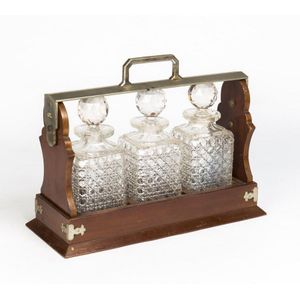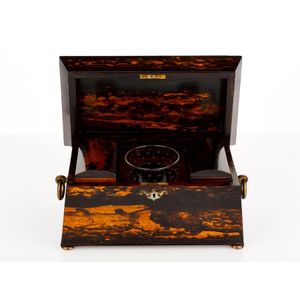Regency Coromandel Tea Caddy with Glass Bowl
You must be a subscriber, and be logged in to view price and dealer details.
Subscribe Now to view actual auction price for this item
When you subscribe, you have the option of setting the currency in which to display prices to $Au, $US, $NZ or Stg.
- Regency Period - The Regency period in English furniture design refers to the period when King George III, was declared unfit to rule in 1811, and his son ruled as proxy as Prince Regent, until 1820, and then, after the death of his father as George IV until his death in 1830. The Regency period was preceded by the Georgian period (George I, George II, and George III: 1714 - 1811), and was followed by the William IV period, which only lasted until 1837 when William IV died as was succeeded by Queen Victoria.
- Calamander / Coromandel - Calamander wood, also known as coromandel wood or coromandel ebony, is a type of hardwood that comes from the Calamander tree (Diospyros quaesita), which is native to Sri Lanka, India, and Southeast Asia. The wood is known for its dark brown or black colour and its distinctive figuring, which can resemble a snakeskin pattern.
The wood is highly prized for its beauty and durability. It is often used in fine furniture making, particularly in the production of inlaid and marquetry work, as well as in the making of boxes, cabinets, and other decorative items. It is also used in the manufacture of flooring, paneling and other architectural applications.
Calamander wood is a very hard and heavy wood, it has a density of around 1.04 g/cm3. Its density and high natural oil content make it resistant to decay and insects, which is why it is a popular choice for outdoor furniture, flooring and other decorative items.
The wood is also used for turning and carving, but is difficult to work due to its high density and interlocking grain. However, it takes a high natural polish and has a beautiful lustre, which is why it is so sought after.
Due to the high demand and over-exploitation of the natural resources, the calamander tree is now a protected species, and the harvesting and export of the wood is heavily regulated.
This item has been included into following indexes:
- tea caddies, material - coromandel 6
- tea caddies, period or age
Visually similar items

An early-20th century Dutch tortoiseshell case silver coffee spoon set C. 1910, the case with raised domed lid and serpentine front, ivory border rim with bun feet. Twelve silver spoons and sugar shovel (lock no key). Dimensions 15 cm x 18.5 cm

Antique ornate brass inlay dressing box, top opening to fitted interior and lower drawer, width 33 cm x depth 24 cm x height 19 cm

A Chinoiserie toilet mirror. 93 cm high

A Tantalus with 3 hobnail cut crystal decanters, late 19th early 20th century. 32 cm high, 41 cm wide
